Mars population reaches 100
Mars population reaches 100 Three decades after the first manned landing, large teams of scientists are now present on Mars. They numb...
http://kingofdkingz99.blogspot.com/2010/05/mars-population-reaches-100.html
Mars population reaches 100
Three decades after the first manned landing, large teams of scientists are now present on Mars. They number over a hundred and comprise a highly international mix of people. Many have spent so much time on the Red Planet that they are beginning to consider it their permanent home.*
The first civilian tourists have also arrived. Travel to Mars was made cheaper, faster and more efficient thanks to the development of nuclear pulse propulsion. This cut journey times to just a few weeks.*
The primary base – established earlier in the decade – is being expanded with new facilities including a solar power plant, mining equipment, nanofabricators, farms and greenhouses.* Additional bases are being planned too, in order to accommodate the growing population. New vehicles have also been supplied to improve the astronauts' mobility, allowing them to roam hundreds of miles from the base.
The habitat modules are constructed partially underground, to give protection from the ultraviolet glare of the Sun. Meanwhile, radiation-absorbing materials based on advanced nanotechnology are used in spacesuits, as well as on the exterior of the vehicles. These same materials have special filters to block even the tiniest particles of dust, giving long term protection against the environment outside.
All of the above has provided the critical mass needed for self-sufficiency. From this point onward, operations can be conducted entirely independently of Earth.
In the coming years, the first children will be born on Mars.
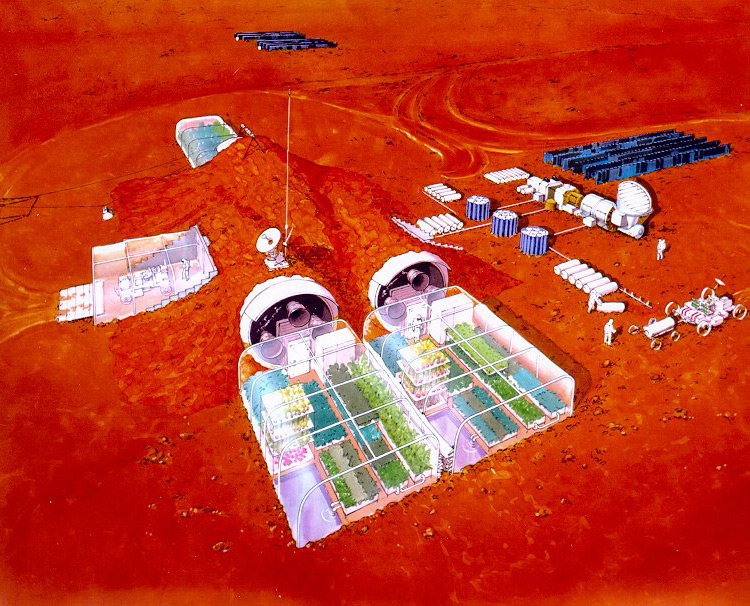
Large-scale civilian settlement of the Moon is underway
As a result of the International Space Elevator, huge numbers of Earth's citizens now have rapid, affordable and safe access to space. Dozens of permanent Moon colonies are now being established, funded by various cooperative groups. Nanotechnology self-assemblers enable these habitats to be constructed in a matter of days.*Most are concentrated in the southern polar region, which has greater access to water.*
Advances in genetic engineering mean that humans can be fully adapted to the gravity of the Moon. In any case, scientists are developing a form of artificial gravity that will soon become available.
In addition to basic exploration and surveying, the main occupations for colonists at the moment are scientific and technological research, mining, agriculture, energy production, communications and transport/infrastructure management. Many tasks are handled by robots, giving more leisure time for the human residents.
Tourism is now a booming industry, with many thousands of people arriving on the Moon's surface each year for guided tours - even though VR simulations can recreate the Moon's environment. The most popular destinations are Mons Huygens (the highest mountain), Tycho (a prominent crater visible from Earth) and the Apollo landing sites.
A very large telescope is also operational, for long-distance astronomical observations. The lack of atmosphere and other conditions gives it a tremendous advantage over Earth-based telescopes.*
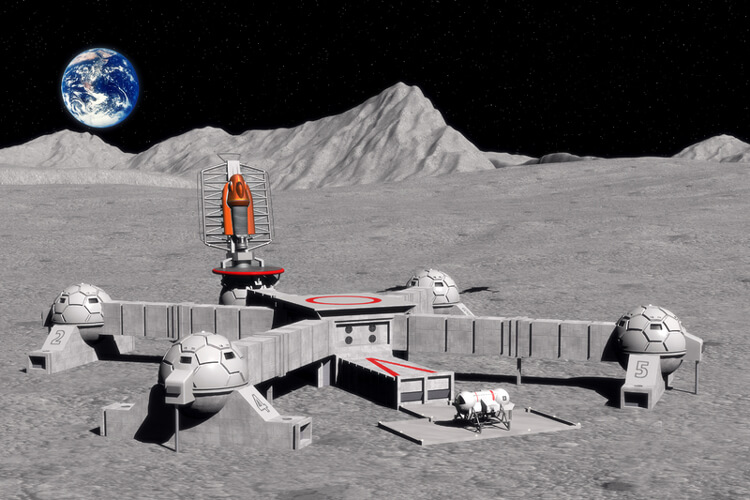
Much of the world is controlled by AI now
Large-scale automation across every industry has led to vast swathes of human employees being replaced by virtual or robotic counterparts. Directed by AI systems of colossal scale and reach, these entities are now ubiquitous in business, government, military, physical labour and manufacturing, and a host of service-based roles.
In the developed world, enormous strides in neuroscience have resulted in human minds being inextricably linked and merged with the Internet. This has amplified and enhanced the day-to-day experiences of the average person in ways that would seem truly profound to citizens of previous centuries. For instance, knowledge and skills on practically any subject can now be downloaded and stored directly within the brain. In addition to basic information and data, this includes a range of physical abilities. A person can learn self-defence, for example, or become an expert in a sport, or be taught complex dance moves, all within a matter of seconds.
Memories and dreams can be recorded, then exported for use in simulations, or shared and experienced with friends and family. Bad memories or negative thought patterns can be erased, or greatly reduced in intensity, just by downloading the right software patch. Similar hi-tech devices now exist for personal medical diagnoses, as well as a plethora of other functions.
The world is being completely transformed by this fusion of people and machines. The vastly greater power of AI means that it has become, at the same time, both master and servant to the human race.

Nomadic floating cities are roaming the oceans
At the dawn of the 22nd century, many of the world’s cities lie partially submerged due to rising sea levels.*Despite some attempts to build flood defences, even famous locations such as New York, London, Hong Kong, Shanghai and Sydney have been affected.
With over 10% of the world's population living on coastlines, hundreds of millions have been forced to migrate. However, disruption of inland food and freshwater supplies – caused by drought, disease, war, overpopulation and other factors – means their journeys often end in vain. Some of the worst-hit countries have been plunged into chaos. Vast uninhabitable wastelands now cover the equatorial regions, with desperate streams of refugees moving from city to city, fighting over what little scraps remain. There is widespread damage to buildings and infrastructure.
In the US, formerly prosperous breadbaskets in the south have been turned into lifeless deserts, while coastal areas are frequently battered by storm surges, category 6 hurricanes and other freak weather events.*
Meanwhile, the once mighty Amazon rainforest has been reduced to a few oases of greenery surrounded by parched scrubland and dried river beds.
A growing number of citizens are abandoning their homelands altogether and attempting to reach more northerly or southerly latitudes. However, borders are becoming ever more difficult to cross. Limited food, resources and housing are forcing many governments to drastically rethink their immigration policies.
Rich entrepreneurs are exploiting this, by offering a new means of living which does away with national boundaries altogether. This comes in the form of floating, artificial islands, which are self-sufficient and capable of cruising around the world.*
The ships offer levels of comfort, safety and security which many of their occupants have never experienced before. In addition to a continuous supply of food, freshwater and energy, a number of facilities are available – including state-of-the-art virtual reality suites, luxury android assistants, industrial-scale nanotech assemblers, landing pads for anti-grav vehicles, swimming pools and other amenities. Carefully maintained arboretums featuring real trees can also be found on board (flora which are becoming increasingly rare these days).
These giant, amphibious ships are especially popular in southeast Asia, which has been hit hardest by the effects of climate change. Some of the largest craft measure over a kilometre in diameter with tens of thousands of residents. Whole new cultures are forming on these "micronations", based on sustainable ways of living and a mutual respect for humanity and nature.*
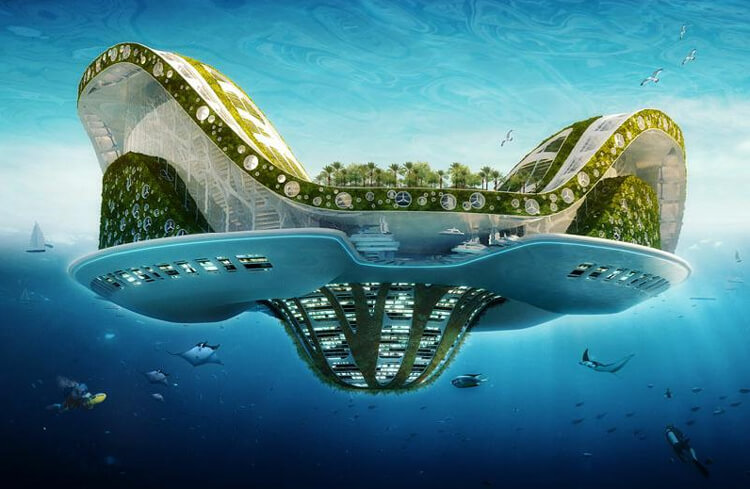
Femtoengineering is becoming possible
Technology on the scale of quadrillionths of a metre (10-15) is becoming possible around this time.* This is three orders of magnitude smaller than picotechnology, and six orders of magnitude smaller than the nanotechnology of a century earlier.
Engineering at this scale involves working directly with the finest known structures of matter - such as quarks and strings - to manipulate the properties of atoms. This development is a further step towards macro-scale teleportation, i.e. transportation of objects visible to the naked eye. Significant breakthroughs in anti-gravity and force field generation will also result from this.
Another area that will see major progress is in materials technology. For example, metals will be produced which are capable of withstanding truly enormous pressures and tensile forces. The applications for this will be endless, but perhaps one of the most exciting areas will be in the exploration of hostile environments - such as probes capable of travelling within the Sun itself, and tunnelling machines that can penetrate the Earth's crust into the layers of magma beneath. Longer term, this development will pave the way for interstellar ships and the massive forces involved in lightspeed travel.
Other more exotic materials are becoming possible - including wholly transparent metals, highly luminous metals, frictionless surfaces, and ultradense but extremely lightweight structures.
As with many areas of science, femtoengineering is being guided by advanced AI, which is now trillions of trillions of times more powerful than unaided human intelligence.
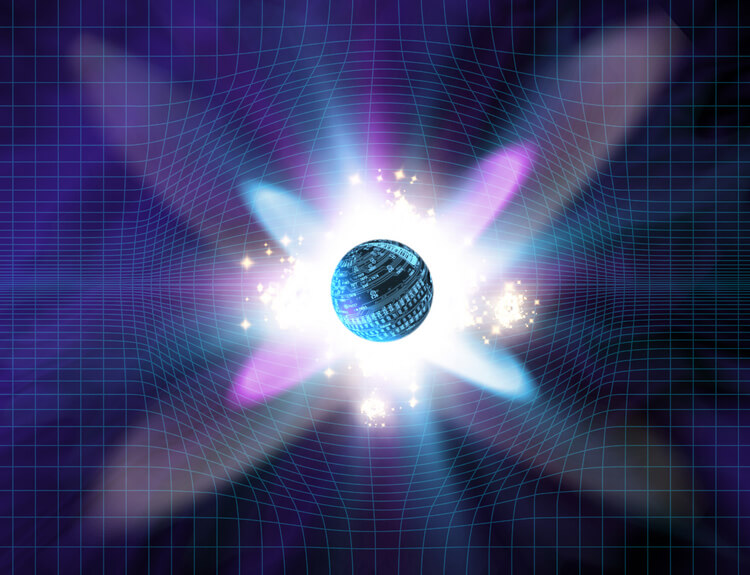
Mind uploading enters mainstream society
Adequate hardware to support human-level intelligence was available as far back as the 2020s, thanks to the exponential progress of Moore's Law.* This made it possible to form simulations of neural processes.
However, the underlying software foundation required for "mind uploading" proved to be a vastly greater challenge. Full transfer of human consciousness into artificial substrates posed enormous technical difficulties, in addition to raising ethical and philosophical issues.
The sheer complexity of the brain, and its inherent fragility - along with the many legislative barriers that stood in the way - meant that it was nearly a century before such technology reached the mainstream.
Some breakthroughs occurred in the latter decades of the 21st century, with partial transfer of memories and thought patterns, allowing some limited experience of the mind uploading process. However, it was only through the emergence of picotechnology and strong AI that sufficiently detailed scanning methods became available. This new generation of machines, being orders of magnitude faster and more robust, finally bridged the gap between organic human brains and their synthetic equivalents.
Initially tested on monkeys, the procedure was eventually offered to certain marginalised people including death row inmates and terminally ill patients. Once it could be demonstrated as being safe and reversible, the project garnered a steady stream of free and healthy volunteers, tempted by this new form of computerised immortality.
Years of red tape and legislation followed, including some of the strictest regulations ever enacted into law. Religious and conservative groups voiced their objections to what they saw as a fundamental violation of God's will. At times, this threatened to postpone the technology indefinitely. Eventually though, like so many other breakthroughs in science, the zeitgeist moved on. The level of demand for mind uploading proved to be enormous, and the treatment was made commercially available in the 2120s.
Today, citizens have access to special clinics in which their biological brains can be literally discarded in favour of artificial ones. Rather than simply "duplicating" a mind, the electronic circuitry physically shifts the consciousness, like a sponge soaking up water. Thus, the original personality remains intact during the transition. This vital aspect of the procedure assuages the fear which many have of losing their identity.
For the wealthiest individuals, entire new bodies can be grown, into which the synthetic brains can be transplanted. These bodies may themselves be artificial, with options for partially cyborg or fully robotic replacements. Externally, they are often indistinguishable from real human bodies, but include many hi-tech add-ons and internal features boosting physical and mental abilities.
Not everyone is opting for these types of treatments, however. A significant percentage view them with extreme suspicion, as though somehow immoral and dehumanising. With each passing year, society is becoming increasingly fractured, with an ever-increasing divide between those who seek to enhance themselves, and those who prefer to eschew such technology.
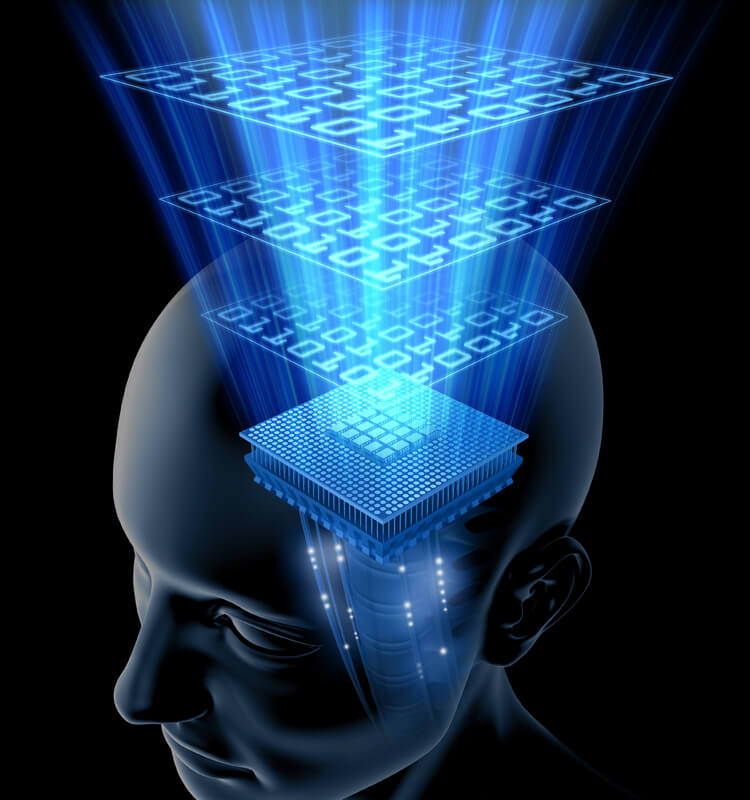
The International Space Elevator is operational
Rising from the Pacific Rim, this mega-structure is thousands of miles high. Decades in the making, it has been built entirely from carbon nanotubes. These are hundreds of times stronger than ordinary steel and capable of withstanding the enormous tensile forces involved. The elevator is controlled largely by AI, which monitors any stresses or unusual conditions.
One major obstacle to the project's completion - aside from the initial outlay - was the need for international agreements on safety, security and insurance in the event of an accident. Although the technology was available as far back as 2040, these issues (and others) delayed construction by many years.
A major space boom is now finally underway, as passengers can be delivered to orbit at vastly reduced costs, compared with traditional rocket launches.*
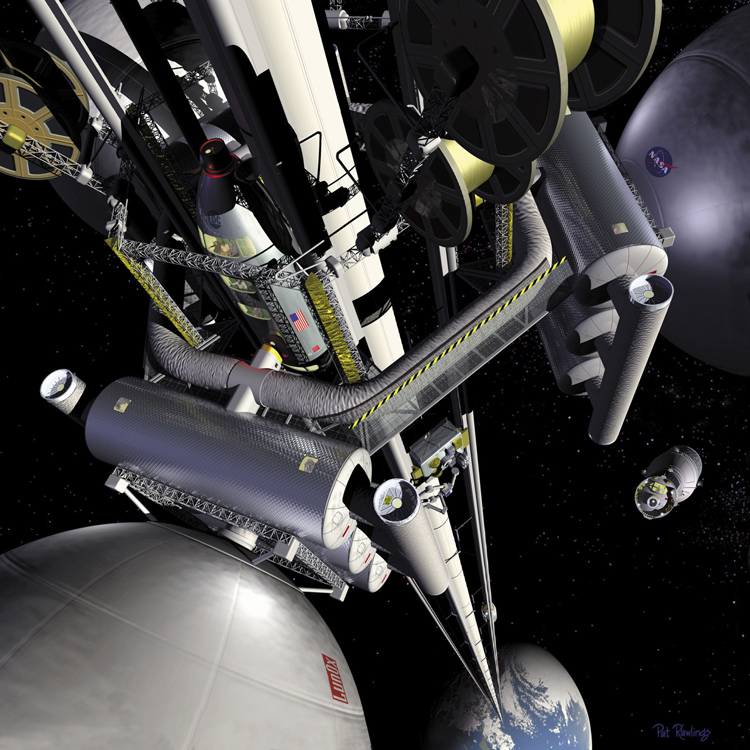


.jpg)



